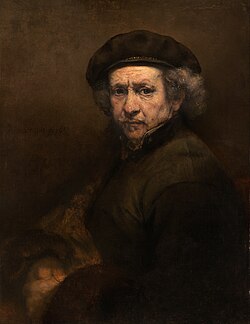Self-Portrait with Beret and Turned-Up Collar
| Self-Portrait with Beret and Turned-Up Collar | |
|---|---|
 |
|
| Artist | Rembrandt |
| Year | 1659 |
| Medium | Oil on canvas |
| Dimensions | 84.4 cm × 66 cm (33.2 in × 26 in) |
| Location | National Gallery of Art, Washington, D.C. |
Self-Portrait with Beret and Turned-Up Collar is a 1659 oil on canvas painting by the Dutch artist Rembrandt, one of over 40 self-portraits by Rembrandt. It has been noted as a self-portrayal of subtle and somber qualities, a work in which may be seen "the stresses and strains of a life compounded of creative triumphs and personal and financial reverses". Part of the Andrew W. Mellon Collection, it has been in the National Gallery of Art since 1937.
In Self-Portrait with Beret and Turned-Up Collar Rembrandt is seated in a broadly painted fur cloak, his hands clasped in his lap. Light from the upper right fully illuminates the face, hollowing the form of the cheek, and allowing for the representation of blemishes on the right cheek and ear lobe. The picture is painted in a restrained range of browns and grays, enriched by a red shape that probably indicates the back of his chair, while another red area at the lower left corner of the canvas may be a tablecloth. The most luminous area, the artist's face, is framed by a large beret and the high collar that flatteringly hides his jowls. The skin of the face is modeled with thick, tactile pigment, painted with rich and varied colors suggesting both the artist's physical aging and the emotional effects of life experience.
At first Rembrandt painted himself wearing a light colored cap before opting for the black beret; since the original headdress was of a type that the artist included only in self-portraits where he is seen at the easel, it is possible that he initially intended for this painting to refer directly to his trade.
The pose is reminiscent of several earlier works by Rembrandt, including an etching from 1639, Self-Portrait Leaning on a Stone Sill, and a painted self-portrait of 1640, now in the National Gallery in London. Both earlier pieces have been viewed as referential to the Portrait of Baldassare Castiglione (Louvre) by Raphael, as well as A Man with a Quilted Sleeve by Titian (NG, London), then wrongly thought to be a portrait of Ludovico Ariosto, which Rembrandt had seen in Amsterdam. The folded hands and the left arm covered in dark fabric are similar to the Raphael portrait.
...
Wikipedia
